Dissertation: Analyzing Digital Marketing's Consumer Behavior Impact
VerifiedAdded on 2020/03/16
|90
|24858
|156
Thesis and Dissertation
AI Summary
This dissertation investigates the impact of digital marketing on consumer buying behavior. It begins with an introduction outlining research objectives, questions, and the study's rationale, followed by a literature review that defines key terms, reviews relevant theories and empirical studies, and establishes a conceptual framework and hypotheses. The methodology chapter details the research approach, design, data collection methods, sampling, ethical considerations, limitations, and data analysis techniques. The data analysis chapter presents demographic profiles, reliability and validity tests, and correlation and regression analyses to test the research objectives. The study concludes with a summary of findings, recommendations, and a survey questionnaire, providing a comprehensive analysis of digital marketing's influence on consumer purchasing decisions and offering insights for marketers and researchers. The document is available on Desklib, a platform providing AI-based study tools.
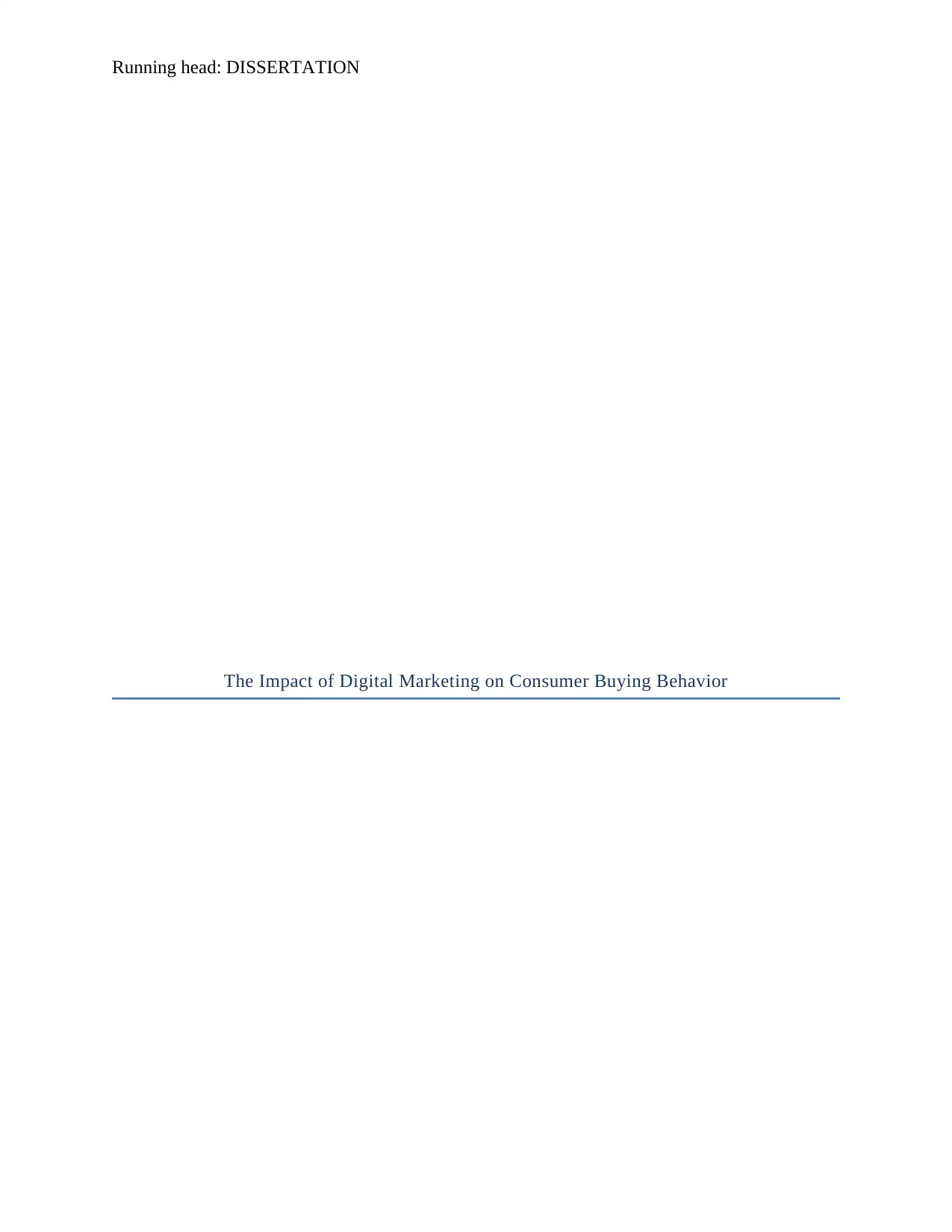
Running head: DISSERTATION
The Impact of Digital Marketing on Consumer Buying Behavior
The Impact of Digital Marketing on Consumer Buying Behavior
Paraphrase This Document
Need a fresh take? Get an instant paraphrase of this document with our AI Paraphraser
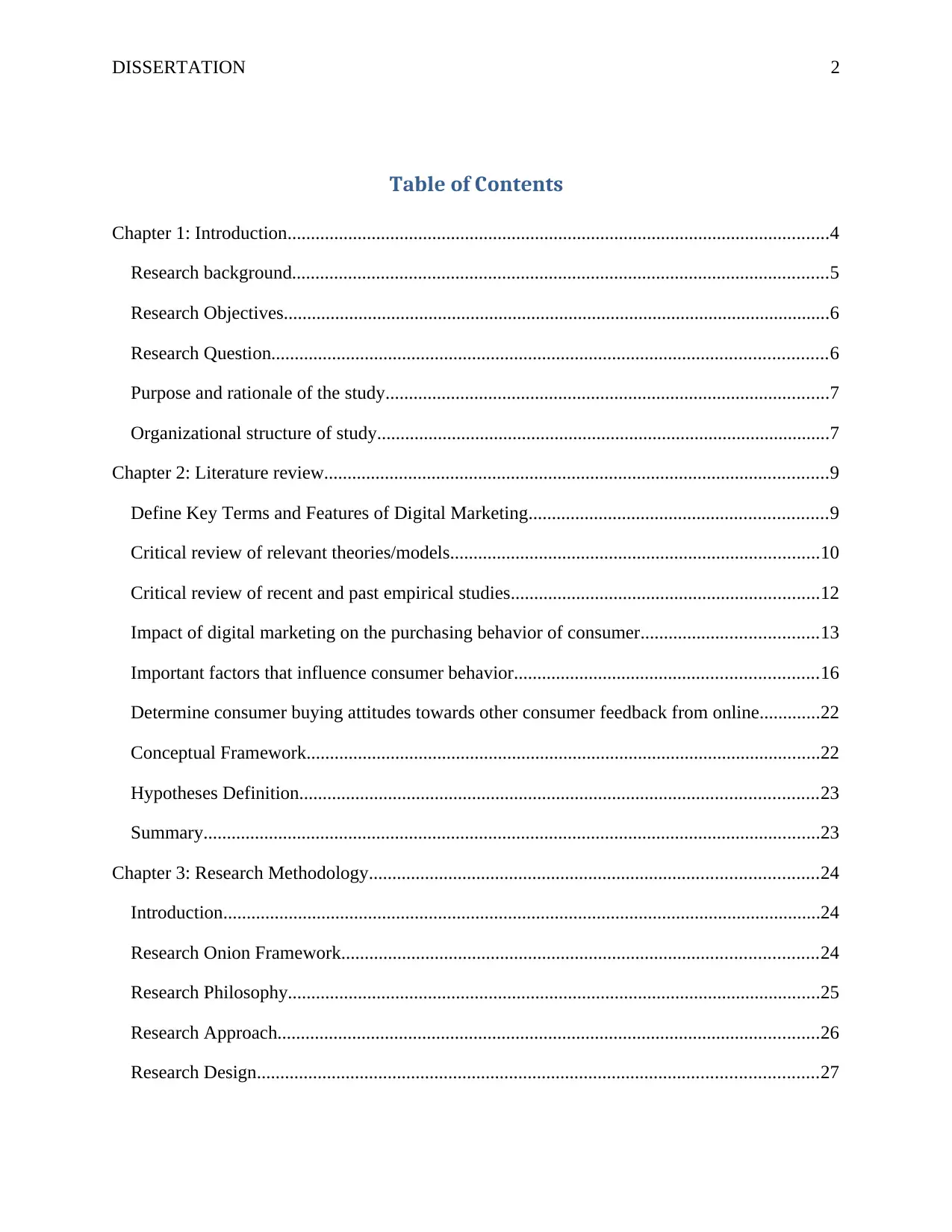
DISSERTATION 2
Table of Contents
Chapter 1: Introduction....................................................................................................................4
Research background...................................................................................................................5
Research Objectives.....................................................................................................................6
Research Question.......................................................................................................................6
Purpose and rationale of the study...............................................................................................7
Organizational structure of study.................................................................................................7
Chapter 2: Literature review............................................................................................................9
Define Key Terms and Features of Digital Marketing................................................................9
Critical review of relevant theories/models...............................................................................10
Critical review of recent and past empirical studies..................................................................12
Impact of digital marketing on the purchasing behavior of consumer......................................13
Important factors that influence consumer behavior.................................................................16
Determine consumer buying attitudes towards other consumer feedback from online.............22
Conceptual Framework..............................................................................................................22
Hypotheses Definition...............................................................................................................23
Summary....................................................................................................................................23
Chapter 3: Research Methodology................................................................................................24
Introduction................................................................................................................................24
Research Onion Framework......................................................................................................24
Research Philosophy..................................................................................................................25
Research Approach....................................................................................................................26
Research Design........................................................................................................................27
Table of Contents
Chapter 1: Introduction....................................................................................................................4
Research background...................................................................................................................5
Research Objectives.....................................................................................................................6
Research Question.......................................................................................................................6
Purpose and rationale of the study...............................................................................................7
Organizational structure of study.................................................................................................7
Chapter 2: Literature review............................................................................................................9
Define Key Terms and Features of Digital Marketing................................................................9
Critical review of relevant theories/models...............................................................................10
Critical review of recent and past empirical studies..................................................................12
Impact of digital marketing on the purchasing behavior of consumer......................................13
Important factors that influence consumer behavior.................................................................16
Determine consumer buying attitudes towards other consumer feedback from online.............22
Conceptual Framework..............................................................................................................22
Hypotheses Definition...............................................................................................................23
Summary....................................................................................................................................23
Chapter 3: Research Methodology................................................................................................24
Introduction................................................................................................................................24
Research Onion Framework......................................................................................................24
Research Philosophy..................................................................................................................25
Research Approach....................................................................................................................26
Research Design........................................................................................................................27
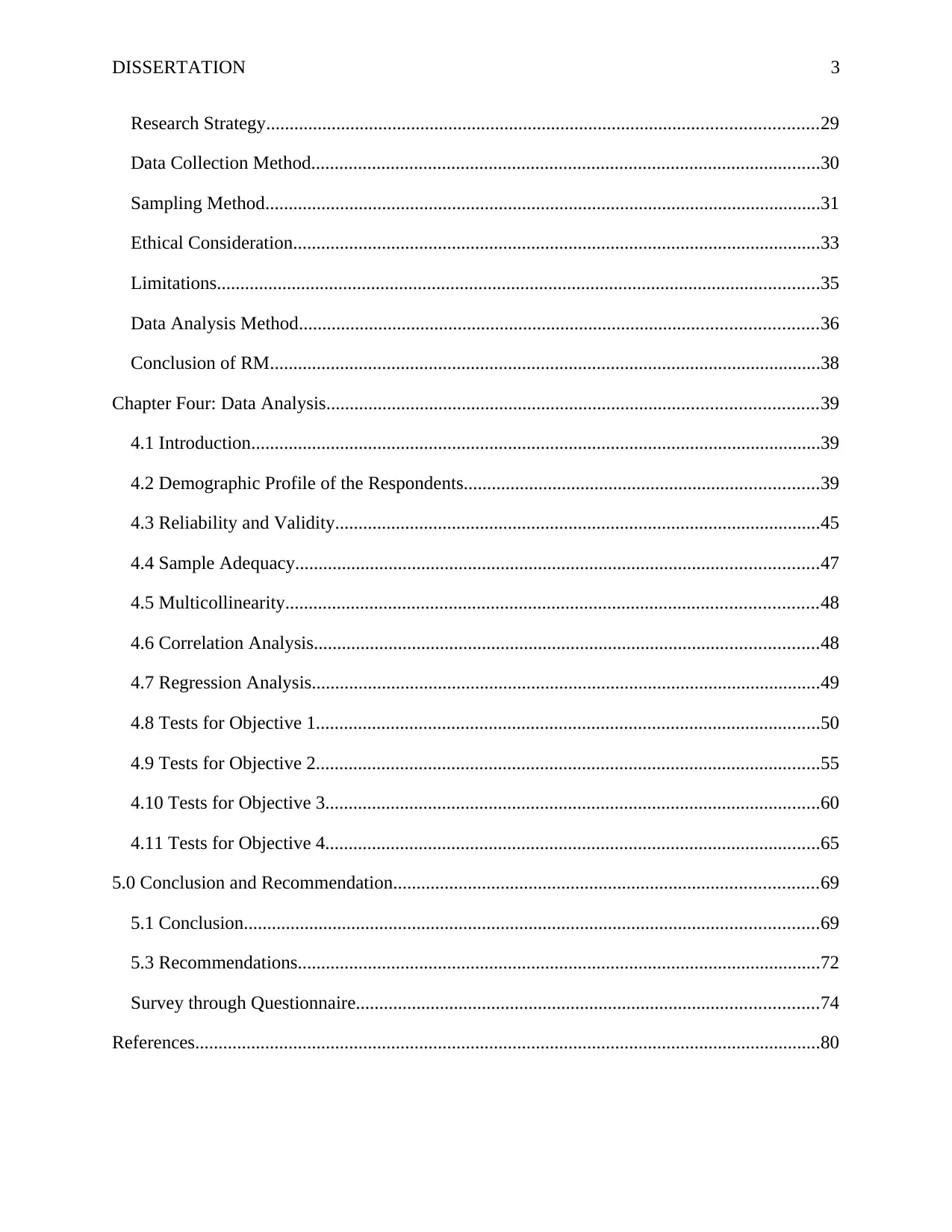
DISSERTATION 3
Research Strategy......................................................................................................................29
Data Collection Method.............................................................................................................30
Sampling Method.......................................................................................................................31
Ethical Consideration.................................................................................................................33
Limitations.................................................................................................................................35
Data Analysis Method...............................................................................................................36
Conclusion of RM......................................................................................................................38
Chapter Four: Data Analysis.........................................................................................................39
4.1 Introduction..........................................................................................................................39
4.2 Demographic Profile of the Respondents............................................................................39
4.3 Reliability and Validity........................................................................................................45
4.4 Sample Adequacy................................................................................................................47
4.5 Multicollinearity..................................................................................................................48
4.6 Correlation Analysis............................................................................................................48
4.7 Regression Analysis.............................................................................................................49
4.8 Tests for Objective 1............................................................................................................50
4.9 Tests for Objective 2............................................................................................................55
4.10 Tests for Objective 3..........................................................................................................60
4.11 Tests for Objective 4..........................................................................................................65
5.0 Conclusion and Recommendation...........................................................................................69
5.1 Conclusion...........................................................................................................................69
5.3 Recommendations................................................................................................................72
Survey through Questionnaire...................................................................................................74
References......................................................................................................................................80
Research Strategy......................................................................................................................29
Data Collection Method.............................................................................................................30
Sampling Method.......................................................................................................................31
Ethical Consideration.................................................................................................................33
Limitations.................................................................................................................................35
Data Analysis Method...............................................................................................................36
Conclusion of RM......................................................................................................................38
Chapter Four: Data Analysis.........................................................................................................39
4.1 Introduction..........................................................................................................................39
4.2 Demographic Profile of the Respondents............................................................................39
4.3 Reliability and Validity........................................................................................................45
4.4 Sample Adequacy................................................................................................................47
4.5 Multicollinearity..................................................................................................................48
4.6 Correlation Analysis............................................................................................................48
4.7 Regression Analysis.............................................................................................................49
4.8 Tests for Objective 1............................................................................................................50
4.9 Tests for Objective 2............................................................................................................55
4.10 Tests for Objective 3..........................................................................................................60
4.11 Tests for Objective 4..........................................................................................................65
5.0 Conclusion and Recommendation...........................................................................................69
5.1 Conclusion...........................................................................................................................69
5.3 Recommendations................................................................................................................72
Survey through Questionnaire...................................................................................................74
References......................................................................................................................................80
⊘ This is a preview!⊘
Do you want full access?
Subscribe today to unlock all pages.

Trusted by 1+ million students worldwide
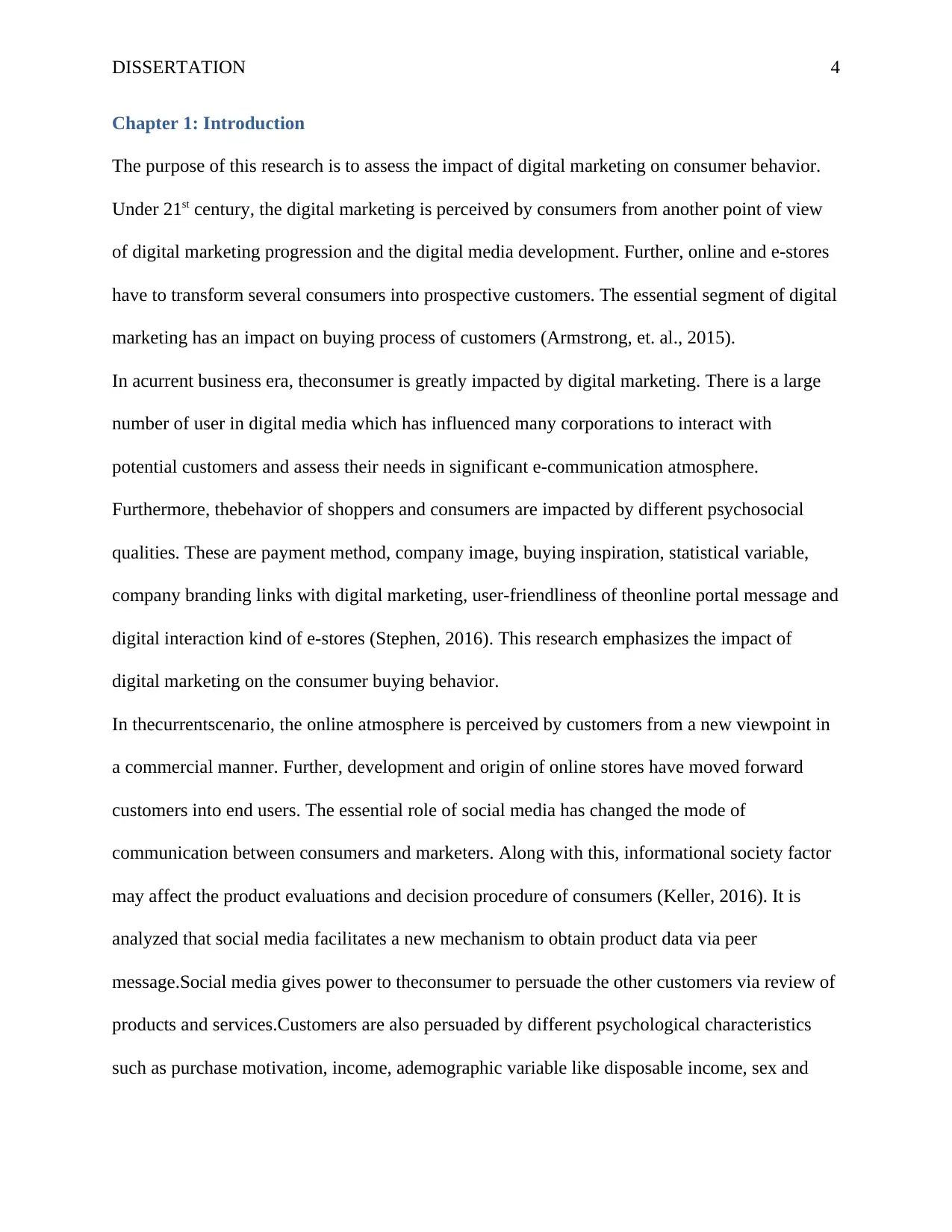
DISSERTATION 4
Chapter 1: Introduction
The purpose of this research is to assess the impact of digital marketing on consumer behavior.
Under 21st century, the digital marketing is perceived by consumers from another point of view
of digital marketing progression and the digital media development. Further, online and e-stores
have to transform several consumers into prospective customers. The essential segment of digital
marketing has an impact on buying process of customers (Armstrong, et. al., 2015).
In acurrent business era, theconsumer is greatly impacted by digital marketing. There is a large
number of user in digital media which has influenced many corporations to interact with
potential customers and assess their needs in significant e-communication atmosphere.
Furthermore, thebehavior of shoppers and consumers are impacted by different psychosocial
qualities. These are payment method, company image, buying inspiration, statistical variable,
company branding links with digital marketing, user-friendliness of theonline portal message and
digital interaction kind of e-stores (Stephen, 2016). This research emphasizes the impact of
digital marketing on the consumer buying behavior.
In thecurrentscenario, the online atmosphere is perceived by customers from a new viewpoint in
a commercial manner. Further, development and origin of online stores have moved forward
customers into end users. The essential role of social media has changed the mode of
communication between consumers and marketers. Along with this, informational society factor
may affect the product evaluations and decision procedure of consumers (Keller, 2016). It is
analyzed that social media facilitates a new mechanism to obtain product data via peer
message.Social media gives power to theconsumer to persuade the other customers via review of
products and services.Customers are also persuaded by different psychological characteristics
such as purchase motivation, income, ademographic variable like disposable income, sex and
Chapter 1: Introduction
The purpose of this research is to assess the impact of digital marketing on consumer behavior.
Under 21st century, the digital marketing is perceived by consumers from another point of view
of digital marketing progression and the digital media development. Further, online and e-stores
have to transform several consumers into prospective customers. The essential segment of digital
marketing has an impact on buying process of customers (Armstrong, et. al., 2015).
In acurrent business era, theconsumer is greatly impacted by digital marketing. There is a large
number of user in digital media which has influenced many corporations to interact with
potential customers and assess their needs in significant e-communication atmosphere.
Furthermore, thebehavior of shoppers and consumers are impacted by different psychosocial
qualities. These are payment method, company image, buying inspiration, statistical variable,
company branding links with digital marketing, user-friendliness of theonline portal message and
digital interaction kind of e-stores (Stephen, 2016). This research emphasizes the impact of
digital marketing on the consumer buying behavior.
In thecurrentscenario, the online atmosphere is perceived by customers from a new viewpoint in
a commercial manner. Further, development and origin of online stores have moved forward
customers into end users. The essential role of social media has changed the mode of
communication between consumers and marketers. Along with this, informational society factor
may affect the product evaluations and decision procedure of consumers (Keller, 2016). It is
analyzed that social media facilitates a new mechanism to obtain product data via peer
message.Social media gives power to theconsumer to persuade the other customers via review of
products and services.Customers are also persuaded by different psychological characteristics
such as purchase motivation, income, ademographic variable like disposable income, sex and
Paraphrase This Document
Need a fresh take? Get an instant paraphrase of this document with our AI Paraphraser
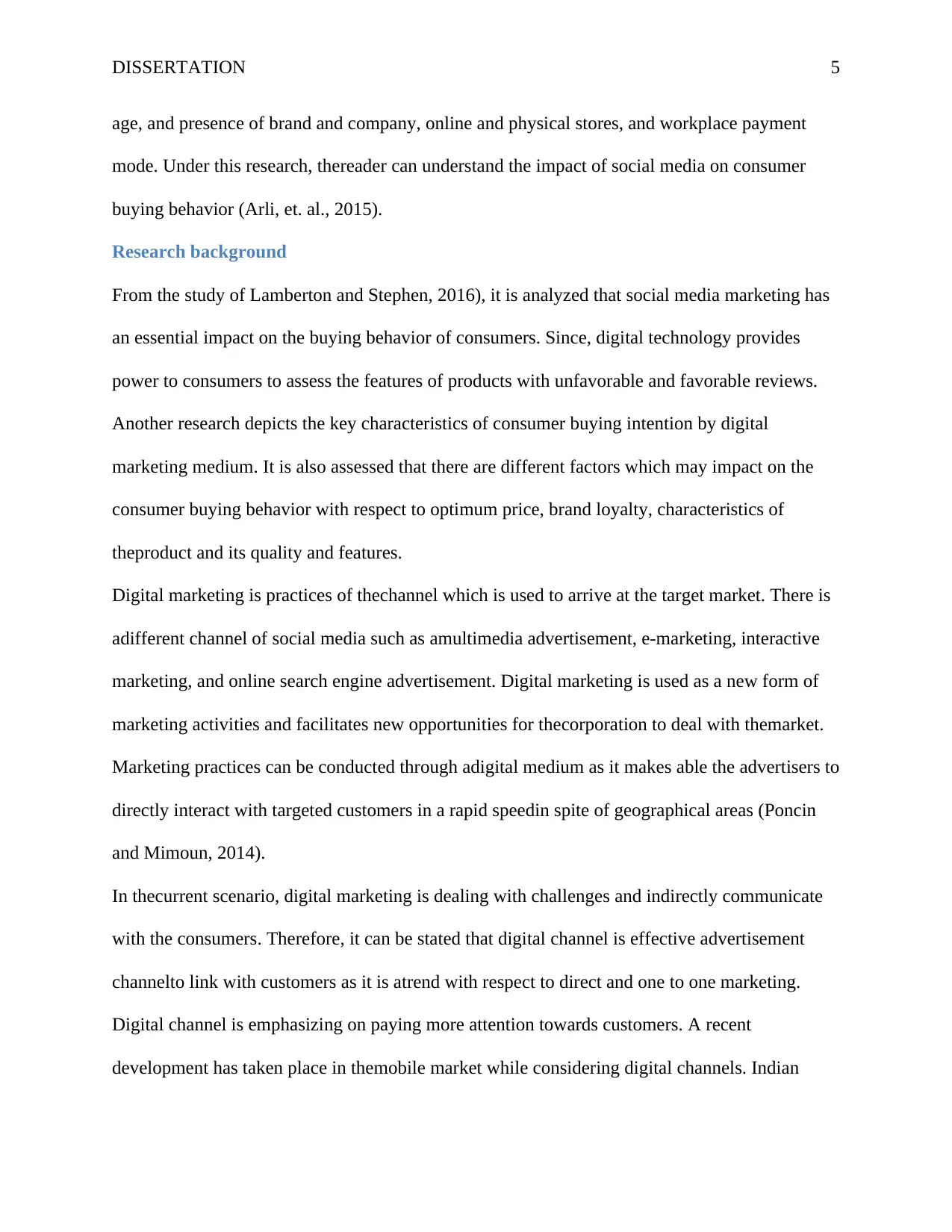
DISSERTATION 5
age, and presence of brand and company, online and physical stores, and workplace payment
mode. Under this research, thereader can understand the impact of social media on consumer
buying behavior (Arli, et. al., 2015).
Research background
From the study of Lamberton and Stephen, 2016), it is analyzed that social media marketing has
an essential impact on the buying behavior of consumers. Since, digital technology provides
power to consumers to assess the features of products with unfavorable and favorable reviews.
Another research depicts the key characteristics of consumer buying intention by digital
marketing medium. It is also assessed that there are different factors which may impact on the
consumer buying behavior with respect to optimum price, brand loyalty, characteristics of
theproduct and its quality and features.
Digital marketing is practices of thechannel which is used to arrive at the target market. There is
adifferent channel of social media such as amultimedia advertisement, e-marketing, interactive
marketing, and online search engine advertisement. Digital marketing is used as a new form of
marketing activities and facilitates new opportunities for thecorporation to deal with themarket.
Marketing practices can be conducted through adigital medium as it makes able the advertisers to
directly interact with targeted customers in a rapid speedin spite of geographical areas (Poncin
and Mimoun, 2014).
In thecurrent scenario, digital marketing is dealing with challenges and indirectly communicate
with the consumers. Therefore, it can be stated that digital channel is effective advertisement
channelto link with customers as it is atrend with respect to direct and one to one marketing.
Digital channel is emphasizing on paying more attention towards customers. A recent
development has taken place in themobile market while considering digital channels. Indian
age, and presence of brand and company, online and physical stores, and workplace payment
mode. Under this research, thereader can understand the impact of social media on consumer
buying behavior (Arli, et. al., 2015).
Research background
From the study of Lamberton and Stephen, 2016), it is analyzed that social media marketing has
an essential impact on the buying behavior of consumers. Since, digital technology provides
power to consumers to assess the features of products with unfavorable and favorable reviews.
Another research depicts the key characteristics of consumer buying intention by digital
marketing medium. It is also assessed that there are different factors which may impact on the
consumer buying behavior with respect to optimum price, brand loyalty, characteristics of
theproduct and its quality and features.
Digital marketing is practices of thechannel which is used to arrive at the target market. There is
adifferent channel of social media such as amultimedia advertisement, e-marketing, interactive
marketing, and online search engine advertisement. Digital marketing is used as a new form of
marketing activities and facilitates new opportunities for thecorporation to deal with themarket.
Marketing practices can be conducted through adigital medium as it makes able the advertisers to
directly interact with targeted customers in a rapid speedin spite of geographical areas (Poncin
and Mimoun, 2014).
In thecurrent scenario, digital marketing is dealing with challenges and indirectly communicate
with the consumers. Therefore, it can be stated that digital channel is effective advertisement
channelto link with customers as it is atrend with respect to direct and one to one marketing.
Digital channel is emphasizing on paying more attention towards customers. A recent
development has taken place in themobile market while considering digital channels. Indian
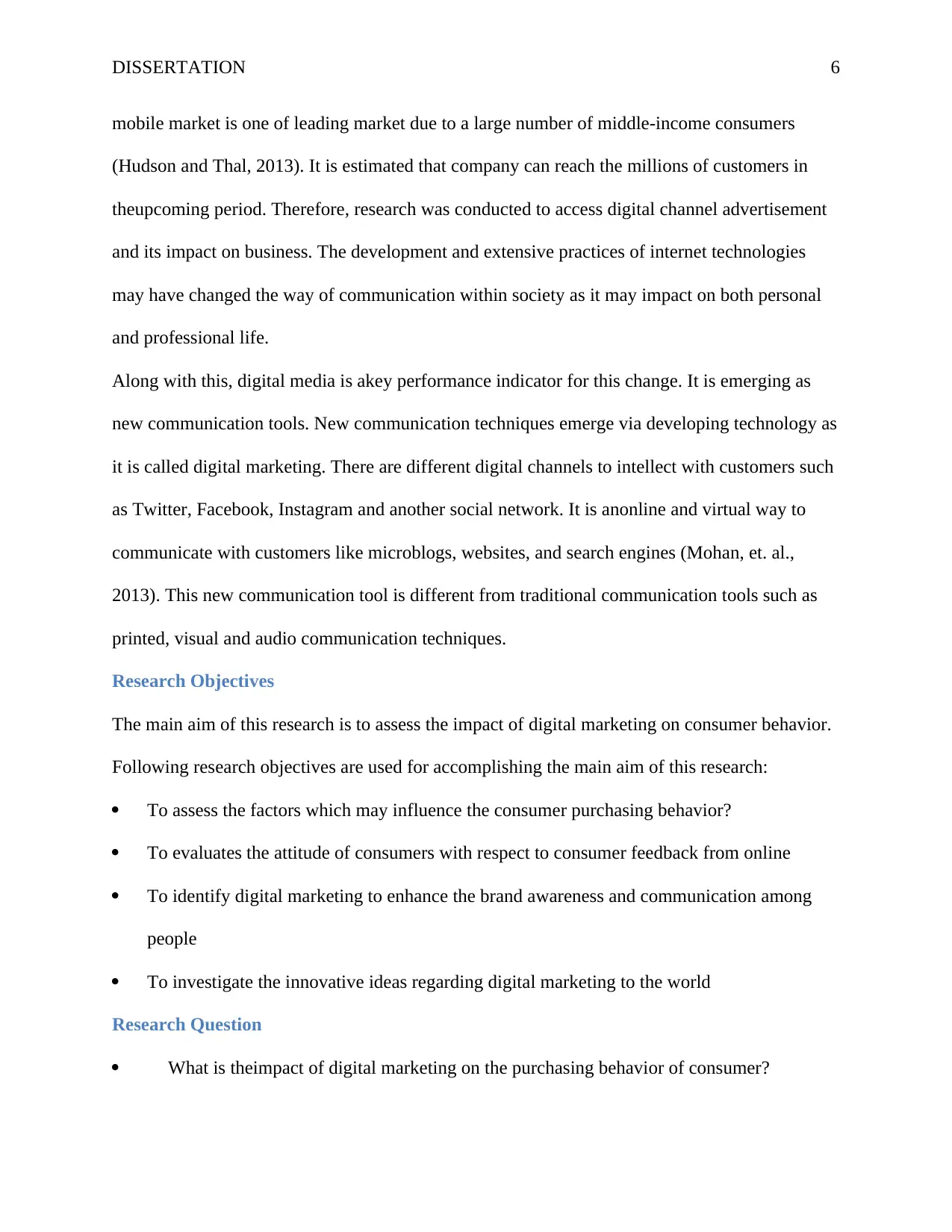
DISSERTATION 6
mobile market is one of leading market due to a large number of middle-income consumers
(Hudson and Thal, 2013). It is estimated that company can reach the millions of customers in
theupcoming period. Therefore, research was conducted to access digital channel advertisement
and its impact on business. The development and extensive practices of internet technologies
may have changed the way of communication within society as it may impact on both personal
and professional life.
Along with this, digital media is akey performance indicator for this change. It is emerging as
new communication tools. New communication techniques emerge via developing technology as
it is called digital marketing. There are different digital channels to intellect with customers such
as Twitter, Facebook, Instagram and another social network. It is anonline and virtual way to
communicate with customers like microblogs, websites, and search engines (Mohan, et. al.,
2013). This new communication tool is different from traditional communication tools such as
printed, visual and audio communication techniques.
Research Objectives
The main aim of this research is to assess the impact of digital marketing on consumer behavior.
Following research objectives are used for accomplishing the main aim of this research:
To assess the factors which may influence the consumer purchasing behavior?
To evaluates the attitude of consumers with respect to consumer feedback from online
To identify digital marketing to enhance the brand awareness and communication among
people
To investigate the innovative ideas regarding digital marketing to the world
Research Question
What is theimpact of digital marketing on the purchasing behavior of consumer?
mobile market is one of leading market due to a large number of middle-income consumers
(Hudson and Thal, 2013). It is estimated that company can reach the millions of customers in
theupcoming period. Therefore, research was conducted to access digital channel advertisement
and its impact on business. The development and extensive practices of internet technologies
may have changed the way of communication within society as it may impact on both personal
and professional life.
Along with this, digital media is akey performance indicator for this change. It is emerging as
new communication tools. New communication techniques emerge via developing technology as
it is called digital marketing. There are different digital channels to intellect with customers such
as Twitter, Facebook, Instagram and another social network. It is anonline and virtual way to
communicate with customers like microblogs, websites, and search engines (Mohan, et. al.,
2013). This new communication tool is different from traditional communication tools such as
printed, visual and audio communication techniques.
Research Objectives
The main aim of this research is to assess the impact of digital marketing on consumer behavior.
Following research objectives are used for accomplishing the main aim of this research:
To assess the factors which may influence the consumer purchasing behavior?
To evaluates the attitude of consumers with respect to consumer feedback from online
To identify digital marketing to enhance the brand awareness and communication among
people
To investigate the innovative ideas regarding digital marketing to the world
Research Question
What is theimpact of digital marketing on the purchasing behavior of consumer?
⊘ This is a preview!⊘
Do you want full access?
Subscribe today to unlock all pages.

Trusted by 1+ million students worldwide
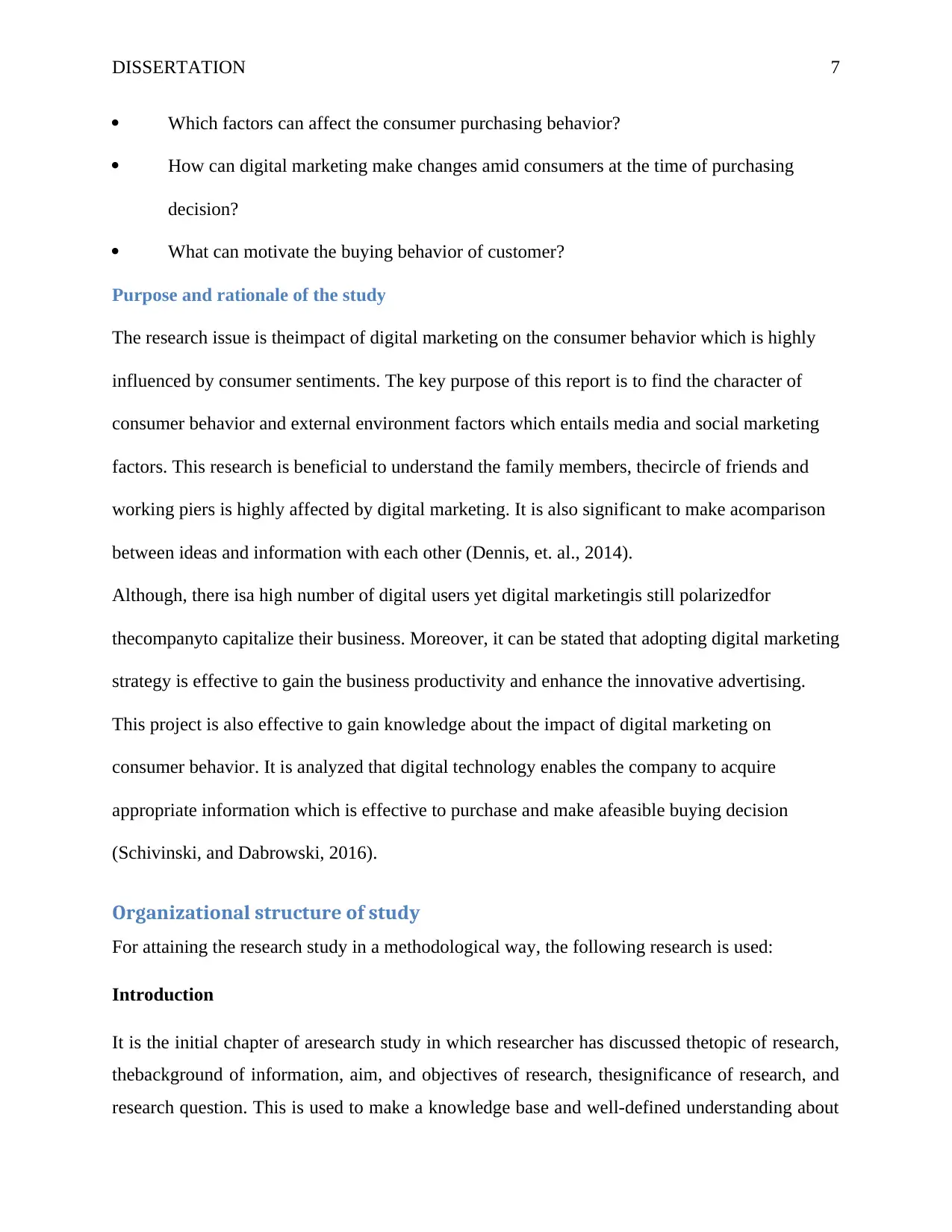
DISSERTATION 7
Which factors can affect the consumer purchasing behavior?
How can digital marketing make changes amid consumers at the time of purchasing
decision?
What can motivate the buying behavior of customer?
Purpose and rationale of the study
The research issue is theimpact of digital marketing on the consumer behavior which is highly
influenced by consumer sentiments. The key purpose of this report is to find the character of
consumer behavior and external environment factors which entails media and social marketing
factors. This research is beneficial to understand the family members, thecircle of friends and
working piers is highly affected by digital marketing. It is also significant to make acomparison
between ideas and information with each other (Dennis, et. al., 2014).
Although, there isa high number of digital users yet digital marketingis still polarizedfor
thecompanyto capitalize their business. Moreover, it can be stated that adopting digital marketing
strategy is effective to gain the business productivity and enhance the innovative advertising.
This project is also effective to gain knowledge about the impact of digital marketing on
consumer behavior. It is analyzed that digital technology enables the company to acquire
appropriate information which is effective to purchase and make afeasible buying decision
(Schivinski, and Dabrowski, 2016).
Organizational structure of study
For attaining the research study in a methodological way, the following research is used:
Introduction
It is the initial chapter of aresearch study in which researcher has discussed thetopic of research,
thebackground of information, aim, and objectives of research, thesignificance of research, and
research question. This is used to make a knowledge base and well-defined understanding about
Which factors can affect the consumer purchasing behavior?
How can digital marketing make changes amid consumers at the time of purchasing
decision?
What can motivate the buying behavior of customer?
Purpose and rationale of the study
The research issue is theimpact of digital marketing on the consumer behavior which is highly
influenced by consumer sentiments. The key purpose of this report is to find the character of
consumer behavior and external environment factors which entails media and social marketing
factors. This research is beneficial to understand the family members, thecircle of friends and
working piers is highly affected by digital marketing. It is also significant to make acomparison
between ideas and information with each other (Dennis, et. al., 2014).
Although, there isa high number of digital users yet digital marketingis still polarizedfor
thecompanyto capitalize their business. Moreover, it can be stated that adopting digital marketing
strategy is effective to gain the business productivity and enhance the innovative advertising.
This project is also effective to gain knowledge about the impact of digital marketing on
consumer behavior. It is analyzed that digital technology enables the company to acquire
appropriate information which is effective to purchase and make afeasible buying decision
(Schivinski, and Dabrowski, 2016).
Organizational structure of study
For attaining the research study in a methodological way, the following research is used:
Introduction
It is the initial chapter of aresearch study in which researcher has discussed thetopic of research,
thebackground of information, aim, and objectives of research, thesignificance of research, and
research question. This is used to make a knowledge base and well-defined understanding about
Paraphrase This Document
Need a fresh take? Get an instant paraphrase of this document with our AI Paraphraser
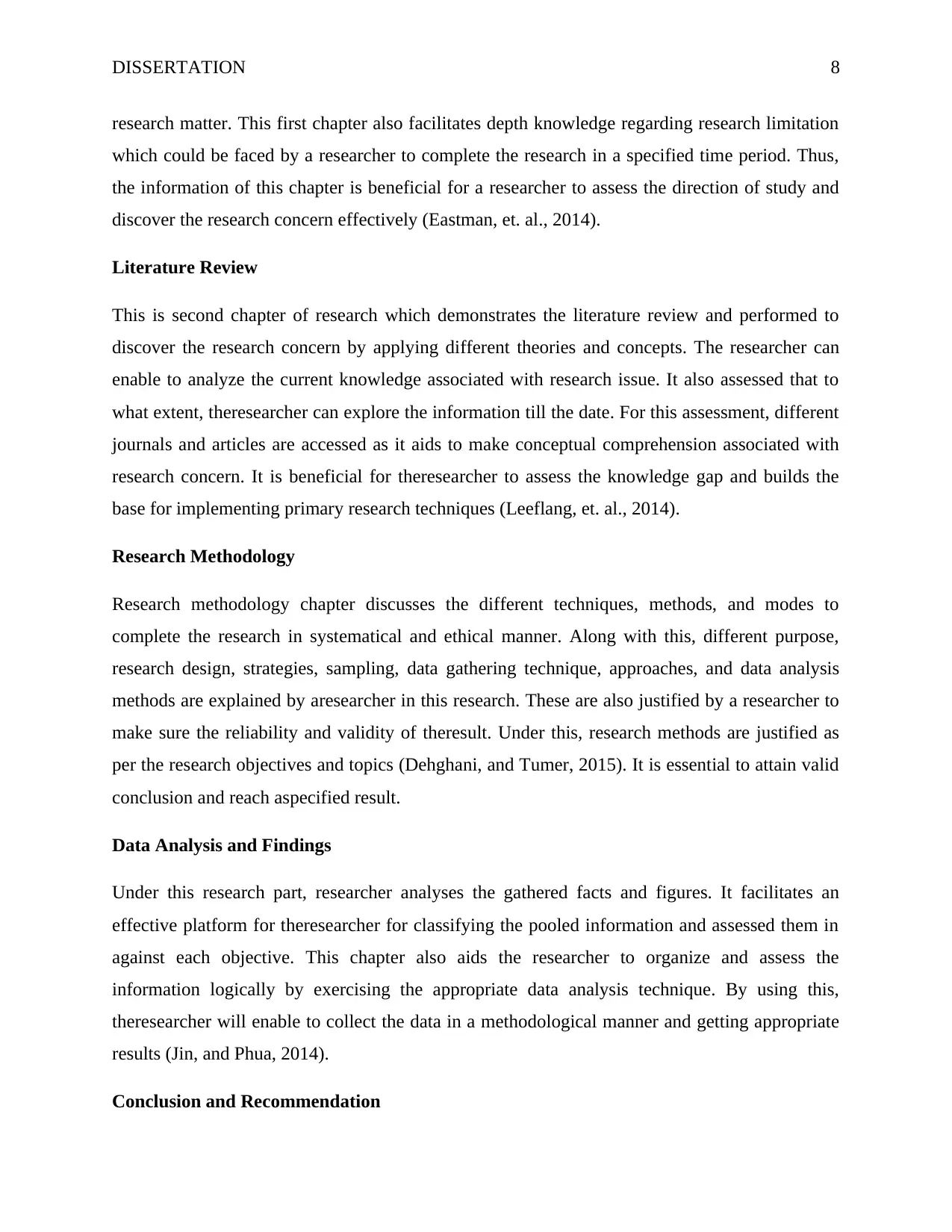
DISSERTATION 8
research matter. This first chapter also facilitates depth knowledge regarding research limitation
which could be faced by a researcher to complete the research in a specified time period. Thus,
the information of this chapter is beneficial for a researcher to assess the direction of study and
discover the research concern effectively (Eastman, et. al., 2014).
Literature Review
This is second chapter of research which demonstrates the literature review and performed to
discover the research concern by applying different theories and concepts. The researcher can
enable to analyze the current knowledge associated with research issue. It also assessed that to
what extent, theresearcher can explore the information till the date. For this assessment, different
journals and articles are accessed as it aids to make conceptual comprehension associated with
research concern. It is beneficial for theresearcher to assess the knowledge gap and builds the
base for implementing primary research techniques (Leeflang, et. al., 2014).
Research Methodology
Research methodology chapter discusses the different techniques, methods, and modes to
complete the research in systematical and ethical manner. Along with this, different purpose,
research design, strategies, sampling, data gathering technique, approaches, and data analysis
methods are explained by aresearcher in this research. These are also justified by a researcher to
make sure the reliability and validity of theresult. Under this, research methods are justified as
per the research objectives and topics (Dehghani, and Tumer, 2015). It is essential to attain valid
conclusion and reach aspecified result.
Data Analysis and Findings
Under this research part, researcher analyses the gathered facts and figures. It facilitates an
effective platform for theresearcher for classifying the pooled information and assessed them in
against each objective. This chapter also aids the researcher to organize and assess the
information logically by exercising the appropriate data analysis technique. By using this,
theresearcher will enable to collect the data in a methodological manner and getting appropriate
results (Jin, and Phua, 2014).
Conclusion and Recommendation
research matter. This first chapter also facilitates depth knowledge regarding research limitation
which could be faced by a researcher to complete the research in a specified time period. Thus,
the information of this chapter is beneficial for a researcher to assess the direction of study and
discover the research concern effectively (Eastman, et. al., 2014).
Literature Review
This is second chapter of research which demonstrates the literature review and performed to
discover the research concern by applying different theories and concepts. The researcher can
enable to analyze the current knowledge associated with research issue. It also assessed that to
what extent, theresearcher can explore the information till the date. For this assessment, different
journals and articles are accessed as it aids to make conceptual comprehension associated with
research concern. It is beneficial for theresearcher to assess the knowledge gap and builds the
base for implementing primary research techniques (Leeflang, et. al., 2014).
Research Methodology
Research methodology chapter discusses the different techniques, methods, and modes to
complete the research in systematical and ethical manner. Along with this, different purpose,
research design, strategies, sampling, data gathering technique, approaches, and data analysis
methods are explained by aresearcher in this research. These are also justified by a researcher to
make sure the reliability and validity of theresult. Under this, research methods are justified as
per the research objectives and topics (Dehghani, and Tumer, 2015). It is essential to attain valid
conclusion and reach aspecified result.
Data Analysis and Findings
Under this research part, researcher analyses the gathered facts and figures. It facilitates an
effective platform for theresearcher for classifying the pooled information and assessed them in
against each objective. This chapter also aids the researcher to organize and assess the
information logically by exercising the appropriate data analysis technique. By using this,
theresearcher will enable to collect the data in a methodological manner and getting appropriate
results (Jin, and Phua, 2014).
Conclusion and Recommendation
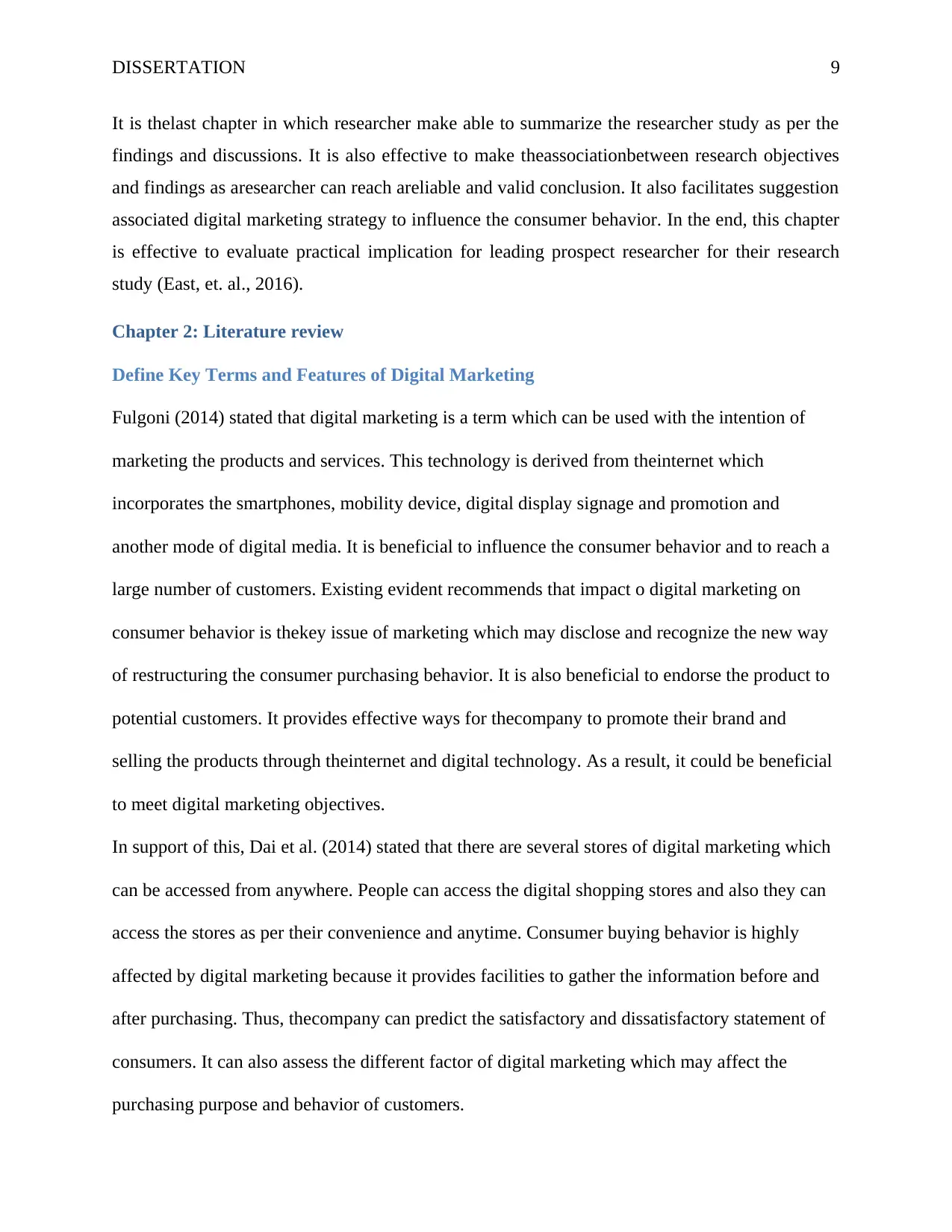
DISSERTATION 9
It is thelast chapter in which researcher make able to summarize the researcher study as per the
findings and discussions. It is also effective to make theassociationbetween research objectives
and findings as aresearcher can reach areliable and valid conclusion. It also facilitates suggestion
associated digital marketing strategy to influence the consumer behavior. In the end, this chapter
is effective to evaluate practical implication for leading prospect researcher for their research
study (East, et. al., 2016).
Chapter 2: Literature review
Define Key Terms and Features of Digital Marketing
Fulgoni (2014) stated that digital marketing is a term which can be used with the intention of
marketing the products and services. This technology is derived from theinternet which
incorporates the smartphones, mobility device, digital display signage and promotion and
another mode of digital media. It is beneficial to influence the consumer behavior and to reach a
large number of customers. Existing evident recommends that impact o digital marketing on
consumer behavior is thekey issue of marketing which may disclose and recognize the new way
of restructuring the consumer purchasing behavior. It is also beneficial to endorse the product to
potential customers. It provides effective ways for thecompany to promote their brand and
selling the products through theinternet and digital technology. As a result, it could be beneficial
to meet digital marketing objectives.
In support of this, Dai et al. (2014) stated that there are several stores of digital marketing which
can be accessed from anywhere. People can access the digital shopping stores and also they can
access the stores as per their convenience and anytime. Consumer buying behavior is highly
affected by digital marketing because it provides facilities to gather the information before and
after purchasing. Thus, thecompany can predict the satisfactory and dissatisfactory statement of
consumers. It can also assess the different factor of digital marketing which may affect the
purchasing purpose and behavior of customers.
It is thelast chapter in which researcher make able to summarize the researcher study as per the
findings and discussions. It is also effective to make theassociationbetween research objectives
and findings as aresearcher can reach areliable and valid conclusion. It also facilitates suggestion
associated digital marketing strategy to influence the consumer behavior. In the end, this chapter
is effective to evaluate practical implication for leading prospect researcher for their research
study (East, et. al., 2016).
Chapter 2: Literature review
Define Key Terms and Features of Digital Marketing
Fulgoni (2014) stated that digital marketing is a term which can be used with the intention of
marketing the products and services. This technology is derived from theinternet which
incorporates the smartphones, mobility device, digital display signage and promotion and
another mode of digital media. It is beneficial to influence the consumer behavior and to reach a
large number of customers. Existing evident recommends that impact o digital marketing on
consumer behavior is thekey issue of marketing which may disclose and recognize the new way
of restructuring the consumer purchasing behavior. It is also beneficial to endorse the product to
potential customers. It provides effective ways for thecompany to promote their brand and
selling the products through theinternet and digital technology. As a result, it could be beneficial
to meet digital marketing objectives.
In support of this, Dai et al. (2014) stated that there are several stores of digital marketing which
can be accessed from anywhere. People can access the digital shopping stores and also they can
access the stores as per their convenience and anytime. Consumer buying behavior is highly
affected by digital marketing because it provides facilities to gather the information before and
after purchasing. Thus, thecompany can predict the satisfactory and dissatisfactory statement of
consumers. It can also assess the different factor of digital marketing which may affect the
purchasing purpose and behavior of customers.
⊘ This is a preview!⊘
Do you want full access?
Subscribe today to unlock all pages.

Trusted by 1+ million students worldwide

DISSERTATION 10
Critical review of relevant theories/models
Pantano andPriporas (2016) evaluated that there are certain theories which determine the impact
of digital marketing on consumer buying behavior. Social cognitive theory defined that
consumer behavior is dynamic and mutual communication with personal attribution and
expression. It also stated that social environmental factor determines the intention of consumers
towards buying of products and services.
On the other hand,Ioanăs and Stoica (2014) demonstrated that another theory of consumer
behavior evaluated that consumer buying intention has afavorableimpact on existing choice of
purchasing. Consumerbelievesthat digital marketing will have thedesired effect in terms of
offering incremental saving, great deal, and promotion as well as higher social validation.
Further, it can be evaluated that digital marketing is used to motivate the buying process of
consumers.
In support to this,Siamagka et al. (2015) stated that digital marketing such as virtual group and
web-based marketing can change the buyer’s behavior, order as well as companies with
borderless admittance to information. It provides better long-range informal interaction and
facilitates a way for consumer association behavior capability. A large number of consumer
utilizes a certain online communication way to convey such as interpersonal company message
in the inbox and webpage journals. Another wayis to share the views and reviews about the
products and branding. Customers can contact with other purchasers who are perceived as more
target information or used as sources for data. Furthermore, brand loyalty has animpact on the
consumer conduct from securing the data to post negative and positive reviews about buying and
unsatisfactory practices regarding the brand and organization.
Critical review of relevant theories/models
Pantano andPriporas (2016) evaluated that there are certain theories which determine the impact
of digital marketing on consumer buying behavior. Social cognitive theory defined that
consumer behavior is dynamic and mutual communication with personal attribution and
expression. It also stated that social environmental factor determines the intention of consumers
towards buying of products and services.
On the other hand,Ioanăs and Stoica (2014) demonstrated that another theory of consumer
behavior evaluated that consumer buying intention has afavorableimpact on existing choice of
purchasing. Consumerbelievesthat digital marketing will have thedesired effect in terms of
offering incremental saving, great deal, and promotion as well as higher social validation.
Further, it can be evaluated that digital marketing is used to motivate the buying process of
consumers.
In support to this,Siamagka et al. (2015) stated that digital marketing such as virtual group and
web-based marketing can change the buyer’s behavior, order as well as companies with
borderless admittance to information. It provides better long-range informal interaction and
facilitates a way for consumer association behavior capability. A large number of consumer
utilizes a certain online communication way to convey such as interpersonal company message
in the inbox and webpage journals. Another wayis to share the views and reviews about the
products and branding. Customers can contact with other purchasers who are perceived as more
target information or used as sources for data. Furthermore, brand loyalty has animpact on the
consumer conduct from securing the data to post negative and positive reviews about buying and
unsatisfactory practices regarding the brand and organization.
Paraphrase This Document
Need a fresh take? Get an instant paraphrase of this document with our AI Paraphraser
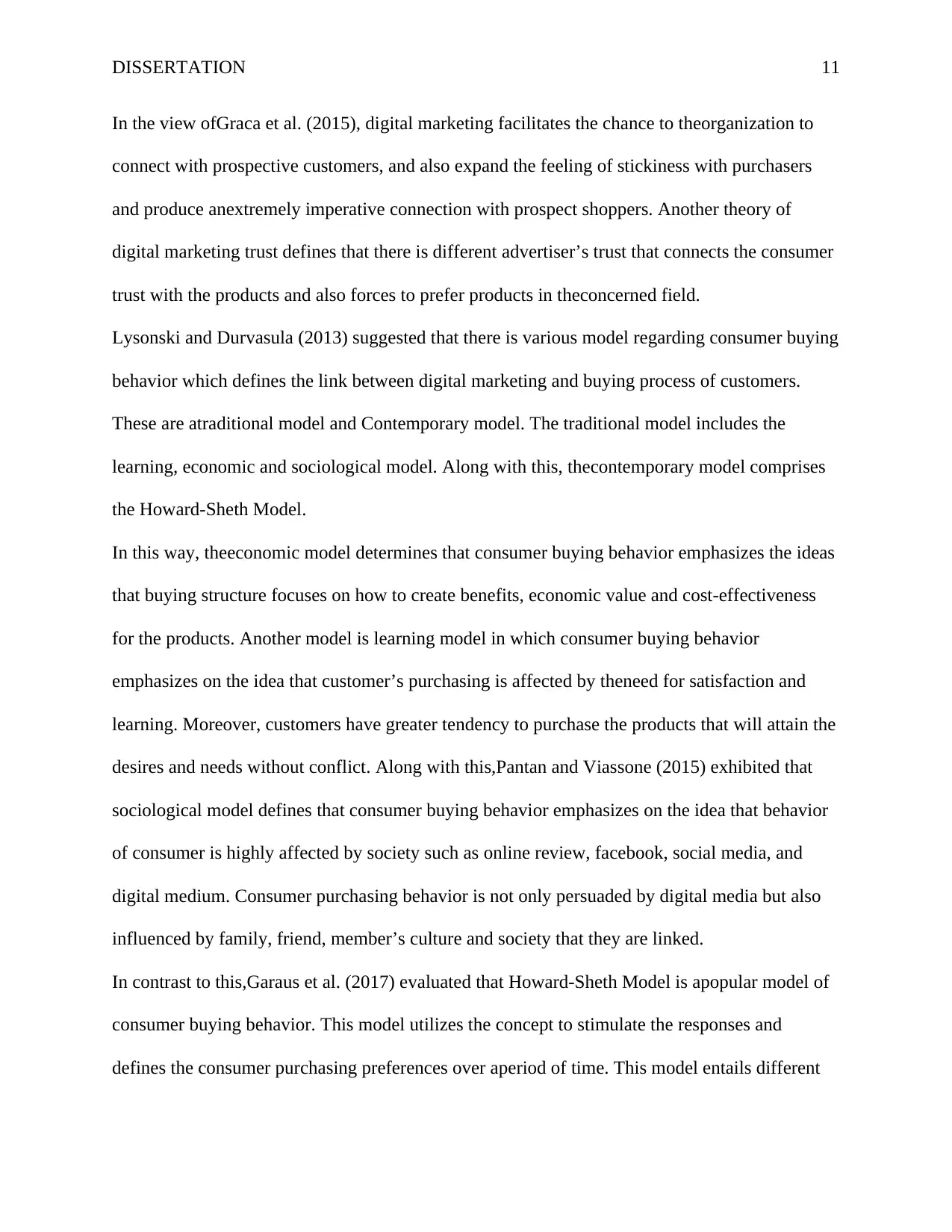
DISSERTATION 11
In the view ofGraca et al. (2015), digital marketing facilitates the chance to theorganization to
connect with prospective customers, and also expand the feeling of stickiness with purchasers
and produce anextremely imperative connection with prospect shoppers. Another theory of
digital marketing trust defines that there is different advertiser’s trust that connects the consumer
trust with the products and also forces to prefer products in theconcerned field.
Lysonski and Durvasula (2013) suggested that there is various model regarding consumer buying
behavior which defines the link between digital marketing and buying process of customers.
These are atraditional model and Contemporary model. The traditional model includes the
learning, economic and sociological model. Along with this, thecontemporary model comprises
the Howard-Sheth Model.
In this way, theeconomic model determines that consumer buying behavior emphasizes the ideas
that buying structure focuses on how to create benefits, economic value and cost-effectiveness
for the products. Another model is learning model in which consumer buying behavior
emphasizes on the idea that customer’s purchasing is affected by theneed for satisfaction and
learning. Moreover, customers have greater tendency to purchase the products that will attain the
desires and needs without conflict. Along with this,Pantan and Viassone (2015) exhibited that
sociological model defines that consumer buying behavior emphasizes on the idea that behavior
of consumer is highly affected by society such as online review, facebook, social media, and
digital medium. Consumer purchasing behavior is not only persuaded by digital media but also
influenced by family, friend, member’s culture and society that they are linked.
In contrast to this,Garaus et al. (2017) evaluated that Howard-Sheth Model is apopular model of
consumer buying behavior. This model utilizes the concept to stimulate the responses and
defines the consumer purchasing preferences over aperiod of time. This model entails different
In the view ofGraca et al. (2015), digital marketing facilitates the chance to theorganization to
connect with prospective customers, and also expand the feeling of stickiness with purchasers
and produce anextremely imperative connection with prospect shoppers. Another theory of
digital marketing trust defines that there is different advertiser’s trust that connects the consumer
trust with the products and also forces to prefer products in theconcerned field.
Lysonski and Durvasula (2013) suggested that there is various model regarding consumer buying
behavior which defines the link between digital marketing and buying process of customers.
These are atraditional model and Contemporary model. The traditional model includes the
learning, economic and sociological model. Along with this, thecontemporary model comprises
the Howard-Sheth Model.
In this way, theeconomic model determines that consumer buying behavior emphasizes the ideas
that buying structure focuses on how to create benefits, economic value and cost-effectiveness
for the products. Another model is learning model in which consumer buying behavior
emphasizes on the idea that customer’s purchasing is affected by theneed for satisfaction and
learning. Moreover, customers have greater tendency to purchase the products that will attain the
desires and needs without conflict. Along with this,Pantan and Viassone (2015) exhibited that
sociological model defines that consumer buying behavior emphasizes on the idea that behavior
of consumer is highly affected by society such as online review, facebook, social media, and
digital medium. Consumer purchasing behavior is not only persuaded by digital media but also
influenced by family, friend, member’s culture and society that they are linked.
In contrast to this,Garaus et al. (2017) evaluated that Howard-Sheth Model is apopular model of
consumer buying behavior. This model utilizes the concept to stimulate the responses and
defines the consumer purchasing preferences over aperiod of time. This model entails different

DISSERTATION 12
components such as output variable, input variable, exogenous, and hypothetical and constructs
variables.
Critical review of recent and past empirical studies
Past research of Andrews and Shimp (2017) shows that the company can measure the
unfavorable information by using the consumer’s post, and various reviews which will have
asubstantial impact on the consumer state of mind. It is found that people and consumer
expression have anessential requirement for obsessive securities as well as they highly demand
inclusive items to purchase. The link between brand and buyer is significant for thecorporation
as it should be conscious of the customers.
In support to this, Marchand et al. (2017) evaluated that in the digital era, there are several
consumers who utilize digital marketing in their routine practices with the intention of different
reasons and manners. Further, high amount of customers have to need to keep theconstant link
and update with relatives, peers, friends, and partners. Digital marketing is effective to hold the
relation between online customers. Along with this, it is beneficial to maintain the contact with
other person and providing social support and closeness.
From the social perspectives, digital marketing has animpact on the utilization of buyers and also
effect on the objective of online buying. In thecurrent scenario, web and internet based business
can succeed through digital marketing. In this way, thecompany should deliver the added value
customers as it delivers the power to effectively interact with prospective customers. In the
context of online networking, it is stated that organization can directly interconnect with the end
users. It is also analyzed that digital marketing has asignificant impact on the consumer practices
and recognition, and acquiring the critical points to make distinctive business (Godey, et. al.,
2016).
components such as output variable, input variable, exogenous, and hypothetical and constructs
variables.
Critical review of recent and past empirical studies
Past research of Andrews and Shimp (2017) shows that the company can measure the
unfavorable information by using the consumer’s post, and various reviews which will have
asubstantial impact on the consumer state of mind. It is found that people and consumer
expression have anessential requirement for obsessive securities as well as they highly demand
inclusive items to purchase. The link between brand and buyer is significant for thecorporation
as it should be conscious of the customers.
In support to this, Marchand et al. (2017) evaluated that in the digital era, there are several
consumers who utilize digital marketing in their routine practices with the intention of different
reasons and manners. Further, high amount of customers have to need to keep theconstant link
and update with relatives, peers, friends, and partners. Digital marketing is effective to hold the
relation between online customers. Along with this, it is beneficial to maintain the contact with
other person and providing social support and closeness.
From the social perspectives, digital marketing has animpact on the utilization of buyers and also
effect on the objective of online buying. In thecurrent scenario, web and internet based business
can succeed through digital marketing. In this way, thecompany should deliver the added value
customers as it delivers the power to effectively interact with prospective customers. In the
context of online networking, it is stated that organization can directly interconnect with the end
users. It is also analyzed that digital marketing has asignificant impact on the consumer practices
and recognition, and acquiring the critical points to make distinctive business (Godey, et. al.,
2016).
⊘ This is a preview!⊘
Do you want full access?
Subscribe today to unlock all pages.

Trusted by 1+ million students worldwide
1 out of 90
Related Documents
Your All-in-One AI-Powered Toolkit for Academic Success.
+13062052269
info@desklib.com
Available 24*7 on WhatsApp / Email
![[object Object]](/_next/static/media/star-bottom.7253800d.svg)
Unlock your academic potential
Copyright © 2020–2025 A2Z Services. All Rights Reserved. Developed and managed by ZUCOL.





